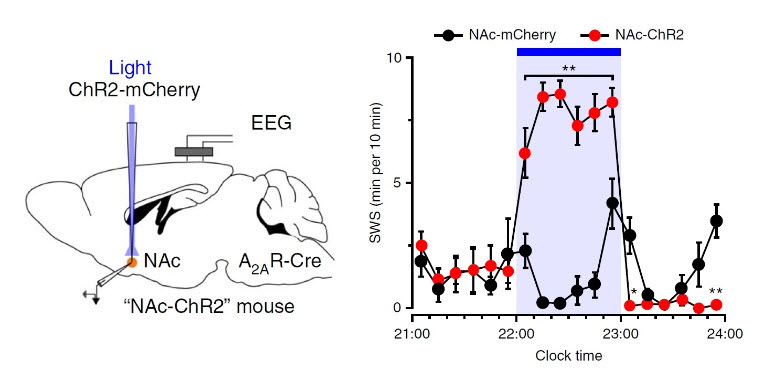マウスの徐波睡眠は側坐核コアの一群のニューロンによって制御される
Slow-wave sleep is controlled by a subset of nucleus accumbens core neurons in mice
2017年9月29日 Nature Communications 8 : 734 doi: 10.1038/s41467-017-00781-4

睡眠の制御は、恒常性による睡眠促進プロセスと概日的プロセスの2つが睡眠の主要な調節因子であるとする、広く受け入れられている2プロセスモデルで説明される。認知的な因子や感情的因子も睡眠覚醒行動に影響するが、これらが睡眠制御に影響する際の基盤となる回路の作用機序の詳細は知られていない。以前の研究で、アデノシンは強化と報酬に重要な脳領域である側坐核(NAc)で働いて、覚醒に影響を及ぼすことが示唆されている。今回我々は、NAcのコア領域中にあって興奮性アデノシンA2A受容体を発現する間接路ニューロンの活動を化学遺伝学あるいは光遺伝学の手法によって活性化すると、徐波睡眠が強力に引き起こされることを示す。また、NAcの間接路ニューロンの活動を化学遺伝学の手法によって阻害すると睡眠誘発が妨げられたが、恒常的な睡眠リバウンドには影響がなかった。一方、モチベーションを高めるような刺激は、腹側淡蒼球に投射するNAc間接路ニューロンの活動を阻害する。我々の得た知見は、モチベーションに関連する睡眠制御にこの間接路が大きく関わっていることを明らかにしている。
Corresponding Authors
Sleep control is ascribed to a two-process model, a widely accepted concept that posits homoeostatic drive and a circadian process as the major sleep-regulating factors. Cognitive and emotional factors also influence sleep–wake behaviour; however, the precise circuit mechanisms underlying their effects on sleep control are unknown. Previous studies suggest that adenosine has a role affecting behavioural arousal in the nucleus accumbens (NAc), a brain area critical for reinforcement and reward. Here, we show that chemogenetic or optogenetic activation of excitatory adenosine A2A receptor-expressing indirect pathway neurons in the core region of the NAc strongly induces slow-wave sleep. Chemogenetic inhibition of the NAc indirect pathway neurons prevents the sleep induction, but does not affect the homoeostatic sleep rebound. In addition, motivational stimuli inhibit the activity of ventral pallidum-projecting NAc indirect pathway neurons and suppress sleep. Our findings reveal a prominent contribution of this indirect pathway to sleep control associated with motivation.

